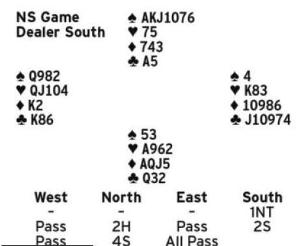THERE is an old adage: ‘eight ever, nine never’. It refers to whether or not to finesse when you have ace-king-jack, missing the queen. With eight cards between the hands your best odds are to finesse: with nine the odds move slightly in favour of bashing out the ace and king, playing for the queen to drop.
With, for example, AJxxx opposite Kxx we cash the king, then play low to the jack. With AKJ10xx opposite xxx it is normal to cash the ace first, in case there is a singleton queen offside, then return to hand to lead low to the jack on the second round. If East shows out it is necessary to return to hand to repeat the finesse.
This deal features a slightly different layout with a slightly different best line.
South reaches 4![]() after a transfer sequence, and West leads the queen of hearts. There is a possible loser in each suit, so declarer must try to avoid a spade loser.
after a transfer sequence, and West leads the queen of hearts. There is a possible loser in each suit, so declarer must try to avoid a spade loser.
Many players start by cashing the ace of spades, then crossing to hand to finesse the jack. That works, but when East shows out the finesse cannot be repeated and the contract fails.
When the cards are divided 6-2 it is best to finesse on the first round. The play makes no difference when the opposing cards are divided 3-2, but it matters when they are 4-1. Finessing on the first round loses to the singleton queen, but gains whenever East has a small singleton, which is four times as likely.
